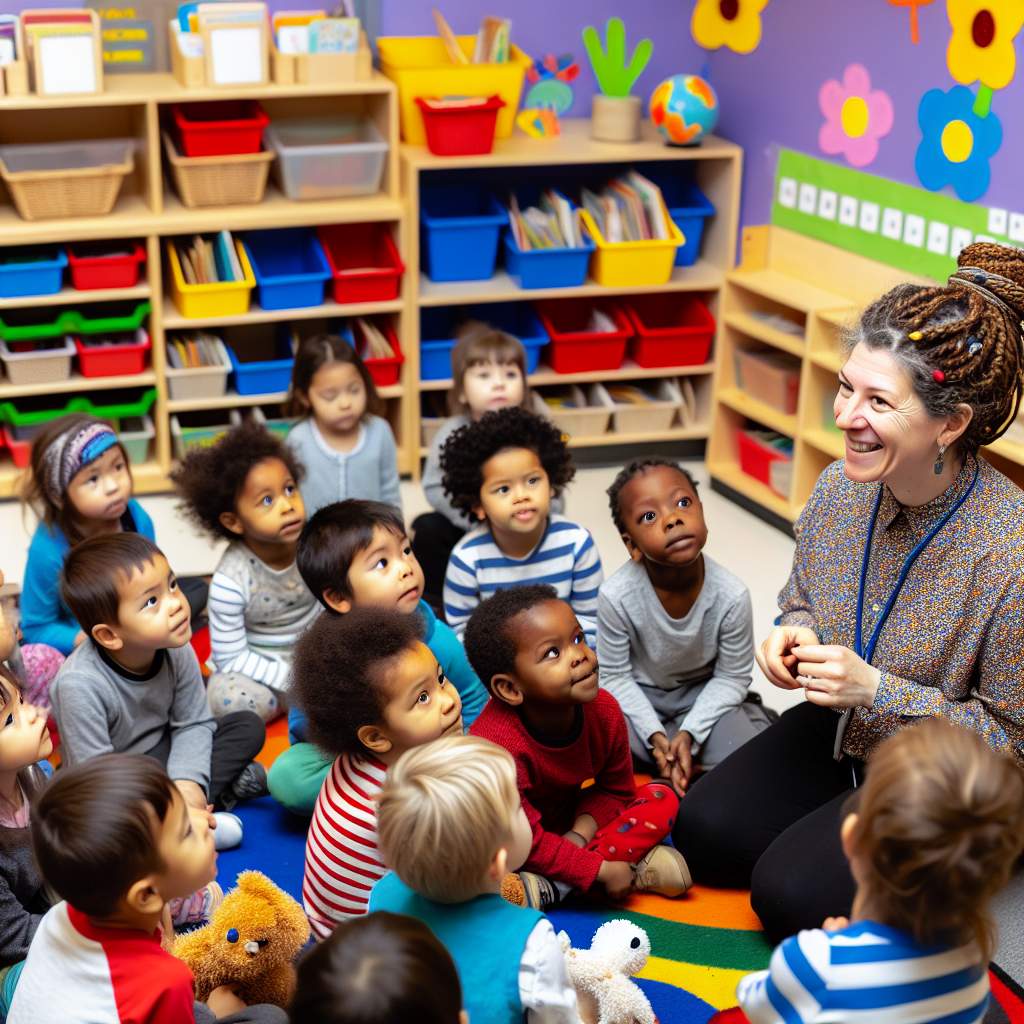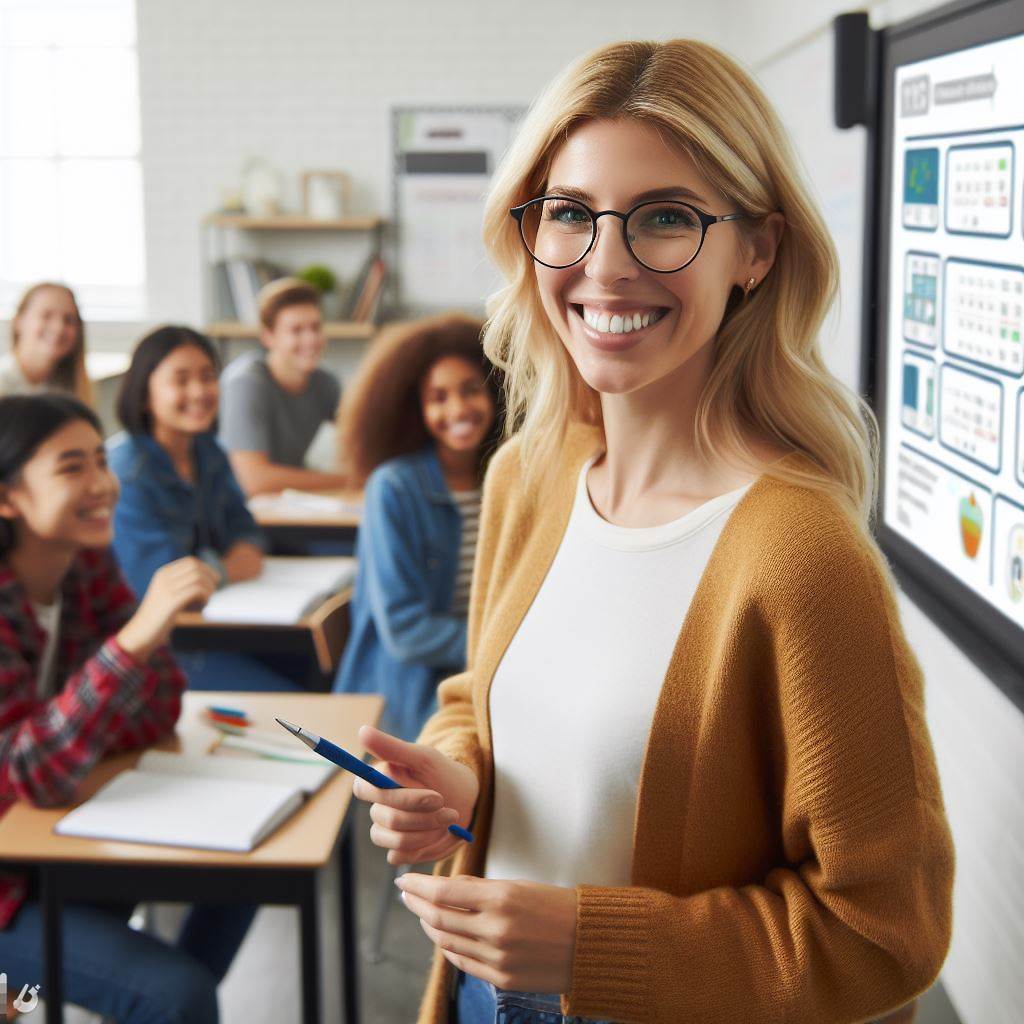Understanding the Developmental Stages of Young Learners
Infants: The Foundation of Learning
Infants rely heavily on their senses to understand the world.
They explore their environment through touch, sight, and sound.
During this stage, caregivers play a vital role in providing sensory experiences.
Responding to an infant’s coos and babbles enhances their language skills.
Furthermore, consistent routines build trust and security.
Toddlers: Discovering Independence
Toddlers are eager to explore their surroundings.
They benefit from safe spaces where they can move freely.
Encouraging decision-making fosters their independence.
Offering choices empowers toddlers and boosts their confidence.
Moreover, social interactions are crucial during this stage.
- Playdates promote sharing and cooperation.
- Group activities enhance communication skills.
Preschoolers: Expanding Horizons
Preschoolers are curious and creative thinkers.
At this stage, they engage in imaginative play.
Teachers can introduce new concepts through play-based learning.
Hands-on activities stimulate their critical thinking abilities.
Additionally, storytelling enriches their vocabulary.
Kindergarteners: Building Social Skills
Kindergarten is a pivotal time for developing social skills.
Children learn to work together and resolve conflicts.
Group projects encourage collaboration and teamwork.
Furthermore, structured environments support their growing independence.
Providing clear guidelines helps children thrive in this stage.
Engaging Young Learners Across Stages
To engage young learners effectively, adapt to their developmental needs.
Use various teaching methods to cater to different learning styles.
Incorporating music and movement captures their attention.
Additionally, a positive and nurturing environment fosters a love for learning.
Ultimately, recognizing and celebrating each child’s progress is essential.
Unlock Your Career Potential
Visualize a clear path to success with our tailored Career Consulting service. Personalized insights in just 1-3 days.
Get StartedCreating a Safe and Stimulating Learning Environment
Establishing a Safe Space
Every child deserves a safe learning environment.
Begin by assessing the classroom layout.
Remove any hazards or distractions from the area.
Ensure that all materials are age-appropriate.
This includes toys, books, and learning tools.
Additionally, conduct regular safety checks.
Be proactive in addressing any safety concerns.
Adding Colorful and Stimulating Decor
Bright colors and inspiring decorations engage young learners.
Consider using themed areas within the classroom.
For example, you could have a reading corner or a science zone.
Add visuals like charts and posters that relate to lessons.
These visuals reinforce learning while making the space inviting.
Encourage children to contribute decorations as well.
This fosters a sense of ownership and pride.
Incorporating Interactive Elements
Engage children with interactive learning stations.
These can include art, science experiments, or sensory bins.
Allow children to explore and learn through play.
Group activities are also vital for collaboration.
Facilitate games and tasks that require teamwork.
Such interactions build social skills and confidence.
Designing Flexible Learning Areas
Flexibility is crucial in the learning environment.
Arrange furniture to be easily adaptable.
This allows for various activities and class sizes.
Provide comfortable seating options to cater to different preferences.
For example, bean bags or floor cushions promote relaxation.
Also, create quiet spaces for individual work or reflection.
This balance helps meet diverse learning needs.
Encouraging Routine and Structure
Establishing a daily routine helps children feel secure.
Clearly communicate the schedule each day.
Use visual aids to help children understand transitions.
For example, a visual timetable can be beneficial.
Moreover, consistency fosters a sense of trust amongst learners.
Encourage children to follow classroom rules and expectations.
This promotes a respectful and focused environment.
Incorporating Play-Based Learning Strategies
Understanding Play-Based Learning
Play-based learning focuses on engaging children through play.
This method makes learning enjoyable and effective.
It fosters creativity and critical thinking in young learners.
Creating a Play-Friendly Environment
Set up classroom spaces for active play and exploration.
Include various learning centers with specific themes.
For instance, a reading nook encourages storytelling.
A science corner promotes hands-on experiments.
Utilizing Hands-On Materials
Offer diverse materials for children to manipulate.
Examples include blocks, art supplies, and sensory bins.
Such items inspire creativity and problem-solving skills.
Encouraging Cooperative Play
Group activities enhance social interaction among children.
Organize team-building games that require collaboration.
Encourage children to share ideas and resources.
Setting Clear Objectives
Define specific learning outcomes for each activity.
Clearly communicate these goals to the children.
This practice helps align play with educational standards.
Integrating Learning Themes
Connect play activities to different subjects.
For example, use a pirate theme to teach about maps.
Integrating themes enhances engagement and retention.
Observing and Assessing Learning
Regularly observe children during play activities.
Take notes on their interactions and skills demonstrated.
Use these observations to adjust future activities.
Encouraging Family Involvement
Invite families to participate in play-based activities.
Organize family days with interactive games and learning stations.
Such involvement strengthens the home-school connection.
You Might Also Like: Skills Every Corporate Trainer Needs to Succeed
Utilizing Multi-Sensory Approaches to Enhance Engagement
The Importance of Multi-Sensory Learning
Multi-sensory learning captures children’s attention effectively.
It engages multiple senses, fostering deeper understanding.
This approach caters to various learning styles.
Children benefit from tactile, visual, and auditory experiences.
By using various modalities, educators can enhance retention.
Incorporating Visual Elements
Visual aids help illustrate concepts clearly.
Use colorful charts, images, and videos in lessons.
Children relate better to visual information.
Interactive whiteboards can enhance visual engagement.
Visual storytelling captivates and motivates young learners.
Enhancing Learning with Auditory Tools
Auditory elements include songs, rhymes, and storytelling.
These tools stimulate listening skills and comprehension.
Engaging children in conversations promotes language development.
Use sound effects to maintain interest during activities.
Group discussions foster social skills and critical thinking.
Integrating Tactile Activities
Tactile experiences make learning tangible and exciting.
Incorporate hands-on activities with various materials.
Using clay, blocks, or sensory bins encourages exploration.
Science experiments create memorable tactile learning moments.
Encouraging play-based learning enhances creativity.
Connecting Movement with Learning
Movement activates children’s bodies and minds.
Incorporate activities that require physical engagement.
Use dance, movement games, and outdoor exploration.
Brain breaks can revitalize students’ focus and energy.
Integrative movement activities promote collaboration and teamwork.
Learn More: Balancing Creativity and Standards in Curriculum Development
Building Strong Relationships with Children and Families
Establishing Trust
Trust forms the foundation of any relationship with children.
Therefore, consistently showing kindness is essential.
Children need to feel safe and valued in your presence.
Display empathy in your interactions to build rapport.
Encourage open conversations to enhance trust.
Encouraging Open Communication
Effective communication sets the tone for a positive environment.
Use clear language that children can easily understand.
Invite children to express their thoughts and feelings.
Provide positive feedback to reinforce their communication.
Use active listening to show that you value their contributions.
Involving Families
Family involvement strengthens children’s learning experiences.
Organize regular family meetings to discuss their child’s progress.
Invite families to participate in classroom activities.
Share resources and strategies that support learning at home.
This collaboration fosters a strong home-school connection.
Creating a Welcoming Environment
A welcoming classroom encourages children to explore.
Display student work to celebrate their achievements.
Offer a variety of activities that cater to different interests.
Ensure the classroom is colorful and inviting.
Finally, be responsive to children’s needs and preferences.
Building Community
Creating a sense of community enhances social skills.
Encourage teamwork and collaborative projects among children.
Organize group activities that foster inclusion.
Celebrate cultural diversity through various cultural activities.
Support children in forming friendships through structured play.
You Might Also Like: Top Qualities of an Effective Youth Program Facilitator
Using Positive Reinforcement and Encouragement
Fostering a Positive Learning Environment
Creating a positive environment is essential for young learners.
Begin by acknowledging their efforts regularly.
Simple phrases like “Great job!” can motivate students.
Also, maintain a friendly tone during interactions.
Ensure that students feel safe to express themselves.
Implementing Reinforcement Techniques
Use reinforcement techniques to promote desired behaviors.
For instance, offer small rewards for achieving milestones.
These can include stickers or extra playtime.
Moreover, praise students individually for specific accomplishments.
This specificity helps them understand what they did well.
Encouraging Peer Support
Encouraging peer encouragement strengthens community bonds.
Pair students for tasks, allowing them to support each other.
Such collaboration fosters social skills and teamwork.
Additionally, create opportunities for group discussions.
This format promotes sharing ideas and encouragement.
Modeling Positive Behavior
Modeling positive behavior impacts young learners significantly.
Exhibit patience and enthusiasm during lessons.
Furthermore, display appropriate responses to challenges.
Your behavior sets expectations for the children.
In doing so, you teach them how to interact positively with others.
Learn More: The Importance of Play in Early Childhood Education Programs

Integrating Technology in Age-Appropriate Ways
Choosing Developmentally Appropriate Tools
Young learners thrive with technology tailored to their age and abilities.
Select devices that are user-friendly and inviting for children.
For example, tablets with colorful, engaging interfaces work well.
Furthermore, ensure apps are designed for educational exploration.
Always look for tools that foster creativity and critical thinking.
Encouraging Interactive Learning Experiences
Interactive experiences promote active engagement in young learners.
Virtual field trips offer exciting ways to explore the world.
In addition, educational games encourage cooperative play among peers.
These activities can help develop essential social skills.
Also, consider incorporating augmented reality into your lessons.
Setting Boundaries for Screen Time
It is crucial to set clear limits on screen time for children.
Experts recommend short sessions that balance technology and other activities.
Encourage regular breaks to prevent overstimulation and fatigue.
Additionally, model healthy tech habits during lesson times.
This teaches children the importance of moderation and mindfulness.
Involving Families in Technology Use
Engaging families enhances the impact of technology in education.
Share resources and recommendations with parents about suitable apps.
Encourage families to participate in tech-enriched activities together.
For example, host workshops on digital storytelling and coding.
Moreover, keep families updated on classroom technology initiatives.
Planning Interactive and Thematic Lessons
Importance of Interactive Learning
Interactive learning captures children’s interest effectively.
It encourages active participation and deepens understanding.
Moreover, it fosters collaboration among young learners.
Choosing a Theme
Selecting a relevant theme makes lessons more engaging.
Consider the interests of the children when choosing themes.
Popular themes include nature, animals, or community helpers.
Furthermore, themes can tie into seasonal or cultural events.
Designing Interactive Activities
Interactive activities stimulate curiosity and exploration.
Include a variety of hands-on experiences in your lessons.
Use art projects, storytelling, and role-playing to engage students.
- Integrate movement-based games to enhance learning.
- Utilize technology with educational apps and videos.
- Encourage group projects that allow teamwork.
Incorporating Different Learning Styles
Recognize that children learn in diverse ways.
Include visual, auditory, and kinesthetic activities in your lessons.
Visual aids such as charts and pictures can enhance understanding.
Auditory components like songs or rhymes support language skills.
Kinesthetic activities encourage physical movement and engagement.
Assessing Engagement
Regularly assess student engagement during lessons.
Observe their reactions and participation levels closely.
Additionally, gather feedback from children about activities.
- Use simple surveys or group discussions.
- Adjust lesson plans based on their preferences.
Adapting Instruction for Diverse Learning Needs
Understanding Individual Differences
Each child develops at their own pace.
Recognizing this is vital for effective teaching.
Furthermore, learning styles can vary widely among students.
Some may prefer visual aids, while others favor hands-on experiences.
Creating a Flexible Learning Environment
A flexible learning space accommodates diverse learning preferences.
Consider using different seating arrangements for various activities.
Additionally, having a variety of resources encourages exploration.
For instance, incorporate books, games, and art supplies.
Utilizing Differentiated Instruction
Differentiated instruction meets the unique needs of each child.
This approach tailors lessons to accommodate varying abilities.
For example, offer multiple ways to complete an assignment.
Some students may excel with written work, while others may prefer presentations.
Integrating Technology for Engagement
Incorporating technology can enhance learning experiences.
Educational apps and interactive tools stimulate engagement.
Moreover, technology can facilitate personalized learning paths.
For instance, children can progress at their own pace through online programs.
Encouraging Collaborative Learning
Collaborative learning fosters social skills among young learners.
Group activities promote interaction and teamwork.
Additionally, working in pairs or teams can build confidence.
This approach allows children to learn from each other.
Assessing Individual Progress
Regular assessments help track each child’s progress.
Use various assessment methods to capture diverse strengths.
Consider observational assessments in addition to formal tests.
These methods provide a fuller picture of a child’s abilities.
Additional Resources
Council for Exceptional Children | The premier association for …




